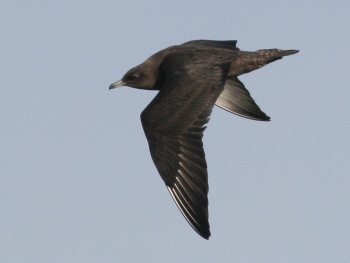m (→External Links: removed BFTV link) |
|||
| (22 intermediate revisions by 10 users not shown) | |||
| Line 1: | Line 1: | ||
| − | + | [[Image:Pomskua 121107 0118.jpg|thumb|550px|right|Photo © by {{user|postcardcv|postcardcv}} <br />Salthouse, Norfolk, [[England]], November 2007]] | |
| − | [[Image: | + | '''Alternative Name: Pomarine Skua''' |
| − | + | ;[[:Category:Stercorarius|Stercorarius]] pomarinus | |
| − | |||
==Identification== | ==Identification== | ||
| − | + | 53cm including 8cm tail projection of broad twisted streamers<br /> | |
| − | + | [[Image:Pomarine_Skua.jpg|thumb|350px|right|Dark phased<br />Photo © by {{user|IanF|IanF}} North Gare, Seaton Carew, Cleveland, [[UK]], November 2007]] | |
| − | + | '''Pale Adult''' | |
| − | + | *Black cap | |
| − | + | *Dark upper parts | |
| − | + | *White underneath with brown breast band and flank bars | |
| + | *White flash on outer wing | ||
| + | '''Dark Adult''' all dusky-brown body<br /> | ||
| + | '''Juveniles''' and '''immature''' variably mottled buff/brown | ||
| + | ====Similar Species==== | ||
| + | * [[Arctic Skua]] | ||
==Distribution== | ==Distribution== | ||
| − | + | Far north of Eurasia and [[North America]]. It is a migrant, wintering at sea in the tropical oceans. | |
| − | |||
==Taxonomy== | ==Taxonomy== | ||
| − | + | This is a [[Dictionary_M-O#M|monotypic]] species<sup>[[#References|[1]]]</sup>. | |
| − | + | [[Image:Spatelraubm we 7.jpg|thumb|350px|right|First year bird<br />Photo © by {{user|storensten|storensten}}<br />Oberkirch, [[Switzerland]], December 2010]] | |
| − | |||
==Habitat== | ==Habitat== | ||
| − | It nests on arctic tundra and islands | + | It nests on arctic tundra and islands |
==Behaviour== | ==Behaviour== | ||
| − | It lays 2-3 olive-brown eggs in grass lined depressions. | + | ====Breeding==== |
| + | It lays 2-3 olive-brown eggs in grass lined depressions. | ||
| + | ====Diet==== | ||
| + | Its diet includes lemmings and other rodents on the breeding grounds. | ||
| − | + | It will also kill birds up to the size of Common Gull. | |
| + | ====Vocalisation==== | ||
| + | {{ Audio|Stercorarius pomarinus (song).mp3 }} | ||
| − | == | + | ==References== |
| − | + | #{{Ref-Clements6thDec10}}#Wikipedia | |
| − | + | #Birdwatchers Pocket Guide ISBN 1-85732-804-3 | |
| + | #Collins Pocket Guide to British Birds 1966 | ||
| + | #Collins Field Guid 5th Edition | ||
| + | {{ref}} | ||
==External Links== | ==External Links== | ||
| − | + | {{GSearch|"Stercorarius pomarinus" {{!}} "Pomarine Skua" {{!}} "Pomarine Jaeger" }} | |
| − | + | {{GS-checked}}1 | |
| − | [[Category:Birds]] | + | <br /> |
| + | <br /> | ||
| + | |||
| + | [[Category:Birds]] [[Category:Stercorarius]] [[Category:Bird Songs]] | ||
Latest revision as of 09:45, 11 May 2023
Alternative Name: Pomarine Skua
- Stercorarius pomarinus
Identification
53cm including 8cm tail projection of broad twisted streamers
Pale Adult
- Black cap
- Dark upper parts
- White underneath with brown breast band and flank bars
- White flash on outer wing
Dark Adult all dusky-brown body
Juveniles and immature variably mottled buff/brown
Similar Species
Distribution
Far north of Eurasia and North America. It is a migrant, wintering at sea in the tropical oceans.
Taxonomy
This is a monotypic species[1].
Habitat
It nests on arctic tundra and islands
Behaviour
Breeding
It lays 2-3 olive-brown eggs in grass lined depressions.
Diet
Its diet includes lemmings and other rodents on the breeding grounds.
It will also kill birds up to the size of Common Gull.
Vocalisation
References
- Clements, JF. 2010. The Clements Checklist of Birds of the World. 6th ed., with updates to December 2010. Ithaca: Cornell Univ. Press. ISBN 978-0801445019. Spreadsheet available at http://www.birds.cornell.edu/clementschecklist/Clements%206.5.xls/view
- Wikipedia
- Birdwatchers Pocket Guide ISBN 1-85732-804-3
- Collins Pocket Guide to British Birds 1966
- Collins Field Guid 5th Edition
Recommended Citation
- BirdForum Opus contributors. (2024) Pomarine Jaeger. In: BirdForum, the forum for wild birds and birding. Retrieved 5 May 2024 from https://www.birdforum.net/opus/Pomarine_Jaeger
External Links
GSearch checked for 2020 platform.1






